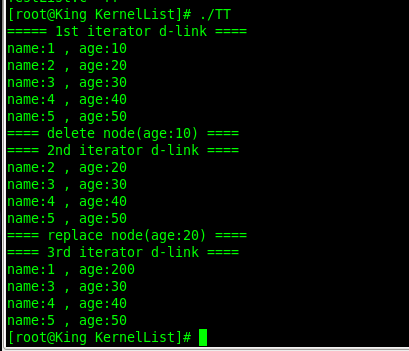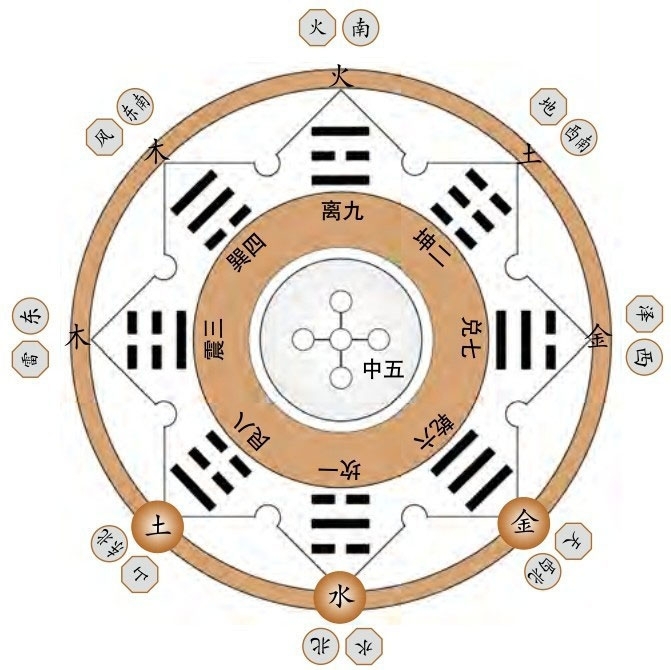0. 概述
学习使用一下 linux 内核链表,在实际开发中我们可以高效的使用该链表帮我们做点事,
链表是Linux 内核中常用的最普通的内建数据结构,链表是一种存放和操作可变数据元
素(常称为节点)的数据结构,链表和静态的数组不同之处在于,它所包含的元素都是动
态创建插入链表的,在编译时不必知道具体需要创建多少个元素。 另外也因为链表中
每个元素的创建时间各不相同,所以它们在内存中无须占用连续内存区,正是因为元素
不连续存放,所以各元素需要通过某种方式被连接在一起,于是每个元素都包含一个指
向下一个元素的指针,当有元素加入链表或从链表中删除元素时,简单调整指向下一个
节点的指针就可以了。
Linux 内核链表采用双向循环链表形式实现, 它的经典在于和普通的链表实现方式相比
可谓独树一帜, 我们普通的一个数据(比如一个 struct) 通过在内部添加一个该数据类型
的next或previous指针,才能串联在链表中, Linux 内核方式与众不同,它不是将数据
塞入链表,而是将链表节点塞入数据结构。
// 普通链表节点 - 将数据类型的指针嵌在里面实现串联 typedef int data_t; typedef struct Node* PNode; typedef struct Node { data_t value; PNode next; PNode prev }Node; // 使用内核链表 struct person { int age; char name[20]; struct list_head list; // 将链表内嵌在数据结构中 };
过去,内核中有许多链表的实现,该选一个即简单、 又高效的链表来一统江湖,在2.1内
核开发系列中首次引入了官方内核链表实现,从此内核中的所有链表现在都用官方的链表
实现了,OK 预热就到这里,这一段话选自<LINUX 内核设计与实现> O ^_^ O
1. 两个牛逼的宏(开胃甜点~)
1.1 offsetof 宏
testOffsetof.c 测试代码
#include <stdio.h> // offsetof 宏 /* 图解 TYPE代表整个结构体 |-----|------| | | | |TYPE |------| | |MEMBER|---> TYPE 中的某一个成员 | |------| | | | |-----|------| 说明:获得结构体(TYPE)的变量成员(MEMBER)在此结构体中的偏移量 1. ((TYPE *)0) 将0转型为TYPE类型指针,即TYPE类型的指针第地址是0 2. ((TYPE *)0)->MEMBER 访问结构中的数据成员 3. &(((TYPE *)0)->MEMBER) 取出成员的地址, 由于TYPE的地址是0,这里获取到的地址 就是相对MEMBER在TYEP中的偏移量 4. (size_t)(&(((TYPE *)0)->MEMBER)) 结果转换类型,对于32位系统, size_t是unsigned int 对于64位系统,size_t是unsigned long类型 TYPE是结构体,它代表"整体";而MEMBER是成员,它是整体中某一部分。 将offsetof看作一个数学问题看待,问题就相当简单了:已知'整体'和'整体中一部分', 而计算该部分在整体中的偏移 */ #define offsetof(TYPE, MEMBER) ((size_t) &((TYPE *)0)->MEMBER) /* struct student 是4字节对齐 ------------| | name | |-----------|<----- 12 | age | |-----------|<----- 8 | id | |-----------|<----- 4 | gender | |-----------|<----- 0 */ struct student { char gender; int id; int age; char name[20]; }; int main() { int gender_offset, id_offset, age_offset, name_offset; gender_offset = offsetof(struct student, gender); id_offset = offsetof(struct student, id); age_offset = offsetof(struct student, age); name_offset = offsetof(struct student, name); printf("gender_offset = %d ", gender_offset); // 0 printf("id_offset = %d ", id_offset); // 4 printf("age_offset = %d ", age_offset); // 8 printf("name_offset = %d ", name_offset); // 12 struct student zhao; printf("sizeof zhao = [%d] ", sizeof(zhao)); // 32个字节 return 0; }
1.2 container_of 宏
testContainer_of.c 测试代码
#include <stdio.h> #include <string.h> #include <stdlib.h> /* container_of 宏 定义: #define container_of(ptr, type, member) ({ const typeof( ((type *)0)->member )*__mptr = (ptr); (type *)( (char *)__mptr - offsetof(type,member));}) 说明: 根据"结构体(type)变量"中的"成员变量(member)的指针(ptr)"来 获取指向整个结构体变量的指针。 1. typeof(((type *)0)->member) 取出member成员的变量类型 2. const typeof(((type *)0)->member)*__mptr = (ptr) 定义 变量__mptr指针,并将ptr赋值给__mptr,经过这一步, __mptr 为member数据类型的常量指针,其指向ptr所指向的地址。 3. (char *)__mptr 将__mptr转换为字符型指针。 4. offsetof(type,member) 就是获取"member"成员在结构体"type" 中的偏移量。 5. ((char *)__mptr - offsetof(type,member)) 就是用来获取 "结构体type"的指针的起始地址(为cha *型指针) 6. (type *)((char *)__mptr - offsetof(type, member)) 就是 将"char *"类型的结构体type的指针转换为"type *"类型的 结构体type 的指针。 */ /* offsetof 宏 * * 获取结构体(TYPE)的变量成员(MEMBER)在此结构体中的偏移量 * */ #define offsetof(TYPE, MEMBER) ((size_t) &((TYPE *)0)->MEMBER) /* container_of 宏 * * 根据结构体(type)变量中的成员变量(member)的指针(ptr),来获取 * 指向整个结构体变量的指针 */ #define container_of(ptr, type, member) ({ const typeof( ((type *)0)->member) *__mptr = (ptr); (type *)( (char *)__mptr - offsetof(type,member)); }) struct student { char gender; int id; int age; char name[20]; }; int main(void) { struct student stu; struct student *pstu; stu.gender = '1'; stu.id = 9527; stu.age = 30; strcpy(stu.name, "James"); // 根据 'id地址' 获取结构体的地址 // container_of(ptr, type, member) pstu = container_of(&stu.id, struct student, id); // 根据获取到的结构体student的地址,访问其他成员 printf("gender = %c ", pstu->gender); printf("age = %d ", pstu->age); printf("name = %s ", pstu->name); return 0; }
2. Linux 内核链表实现及使用Demo
2.1 内核链表实现 list.h 文件(部分函数,主要在学会怎么用)
#ifndef _LINUX_LIST_H #define _LINUX_LIST_H /* 双向链表节点*/ struct list_head { struct list_head *next, *prev; }; /* * 初始化节点 - * * 设置name节点的前继节点和后继节点都指向name本身 * * 相当于: * struct list_head name; * name->next = &name; * name->prev = &name; * 即前驱指针和后继指针都指向自己 */ #define LIST_HEAD_INIT(name) { &(name), &(name) } /* 定义表头(节点) + 初始化 - * * 新建双向循环链表表头name,并设置name的前继节点 * 和后继节点都是指向name本身 */ #define LIST_HEAD(name) struct list_head name = LIST_HEAD_INIT(name) /* 初始化节点 - * * 将list节点的前继节点和后继节点都是指向list本身 */ static inline void INIT_LIST_HEAD(struct list_head *list) { list->next = list; list->prev = list; } /* 添加节点 - * * 将new插入到prev和next之间 在linux中 以'__'开头的函数 * 意味着是内核内部接口,外部不应该调用该接口 */ static inline __list_add(struct list_head *new, struct list_head *prev, struct list_head *next) { next->prev = new; new->next = next; new->prev = prev; prev->next = new; } /* 添加new节点 - * * 将new添加到head之后,new称为head的后继节点 */ static inline void list_add(struct list_head *new, struct list_head *head) { __list_add(new, head, head->next); } /* 添加new节点 - * * 将new添加到head之前,即将new添加到双链表的尾部 */ static inline void list_add_tail(struct list_head *new, struct list_head *head) { __list_add(new, head->prev, head); } /* 从双链表中删除节点 - * * 内核的内部接口,作用是从双链表中删除prev和next之间的节点 */ static inline void __list_del(struct list_head * prev, struct list_head * next) { next->prev = prev; prev->next = next; } /* 从双链表中删除entry节点 - * * 内核对外接口,从链表中删除entry节点 */ static inline void list_del(struct list_head *entry) { __list_del(entry->prev, entry->next); } /* 从双链表中删除entry节点 - * * 在双链表中删除entry节点,内核内部接口 */ static inline void __list_del_entry(struct list_head *entry) { __list_del(entry->prev, entry->next); } /* 从双链表中删除entry节点 - * * 内核对外接口,从双链表中删除entry节点,并将entry节点的前继节点 * 和后继节点都指向entry本身 */ static inline void list_del_init(struct list_head * entry) { __list_del_entry(entry); INIT_LIST_HEAD(entry); } /* * 用new 节点替换old节点 - */ static inline void list_replace(struct list_head *old, struct list_head *new) { new->next = old->next; new->next->prev = new; new->prev = old->prev; new->prev->next = new; } /* * 用new 节点替换old节点 - 将替换的old随即又初始化 */ static inline void list_replace_init(struct list_head *old, struct list_head *new) { list_replace(old, new); INIT_LIST_HEAD(old); } /* * 判断双链表是否为空 - */ static inline list_empty(const struct list_head *head) { return head->next == head; // 判读链表头的后继节点是不是头本身 } /* offsetof 宏 * * 获取'MEMBER'成员在结构体'TYPE'中的偏移量 */ #define offsetof(TYPE,MEMBER) ((size_t)&((TYPE *)0)->MEMBER) /* container_of 宏 * * 根据结构体'type'变量中的域成员变量(member)的指针(ptr) * 来获取指向整个结构体变量的指针 */ #define container_of(ptr,type,member) ({ const typeof( ((type *)0)->member) *__mptr = (ptr); (type *)( (char *)__mptr - offsetof(type,member));}) /* * 遍历双向循环链表 * * 通常用于获取节点,而不能用到删除节点的场景 */ #define list_for_each(pos, head) for(pos =(head)->next; pos != (head); pos = pos->next) /* * 遍历双向循环链表 * * 通常删除节点的场景 */ #define list_for_each_safe(pos, n, head) for(pos = (head)->next, n = pos->next; pos != (head); pos = n, n = pos->next) /* * 获取节点 - * * 调用container_of 宏, 根据结构体(type)变量中的域成员变量(member) * 的指针(ptr)来获取指向整个结构体变量的指针 */ #define list_entry(ptr, type, member) container_of(ptr, type, member); #endif //_LINUX_LIST_H
2.2 使用内核链表Demo test.c文件
/* Linux 内核链表使用测试代码 */ #include <stdio.h> #include <stdlib.h> #include <string.h> #include "list.h" struct person { int age; char name[20]; struct list_head list; //将链表嵌入到结构中 }; int main(int argc, char *argv[]) { struct person *Pperson, *new; struct person person_head; struct list_head *pos, *next; int i; // 初始化双向循环链表头 // INIT_LIST_HEAD(struct list_head *list) INIT_LIST_HEAD(&person_head.list); // 添加节点 for(i=0; i<5; i++) { Pperson = (struct person *)malloc(sizeof(struct person)); Pperson->age = (i+1)*10; sprintf(Pperson->name, "%d", i+1); // 将节点插入到链表的末尾 // 要插入到头,使用list_add // list_add(struct list_head *new, struct list_head *head) // list_add_tail(struct list_head *new, struct list_head *head) list_add_tail(&(Pperson->list), &(person_head.list)); } // 遍历链表 printf("===== 1st iterator d-link ==== "); // 判断链表是否为空 // list_empty(const struct list_head *head) if(!list_empty(&person_head.list)) { // list_for_each(pos, head) list_for_each(pos, &person_head.list) { // list_entry(ptr, type, member) Pperson = list_entry(pos, struct person, list); printf("name:%-2s, age:%d ", Pperson->name, Pperson->age); } } // 删除节点为10的节点 printf("==== delete node(age:10) ==== "); // list_for_each_safe(pos, n, head) list_for_each_safe(pos, next, &person_head.list) { Pperson = list_entry(pos, struct person, list); if(Pperson->age == 10) { // list_del_init(struct list_head * entry) list_del_init(pos); free(Pperson); } } // 再次遍历链表 printf("==== 2nd iterator d-link ==== "); list_for_each(pos, &person_head.list) { Pperson = list_entry(pos, struct person, list); printf("name:%-2s, age:%d ", Pperson->name, Pperson->age); } // 替换节点 printf("==== replace node(age:20) ==== "); new = (struct person *)malloc(sizeof(struct person)); new->age = 200; list_for_each_safe(pos, next, &person_head.list) { Pperson = list_entry(pos, struct person, list); if(Pperson->age == 20) { // list_replace(struct list_head *old, struct list_head *new); list_replace(&(Pperson->list), &(new->list)); } } // 再次遍历链表 printf("==== 3rd iterator d-link ==== "); list_for_each(pos, &person_head.list) { Pperson = list_entry(pos, struct person, list); printf("name:%-2s, age:%d ", Pperson->name, Pperson->age); } // 释放资源 list_for_each_safe(pos, next, &person_head.list) { Pperson = list_entry(pos, struct person, list); list_del_init(pos); free(Pperson); } return 0; }
2.3 运行

3. 鸣谢
感谢下面两位博主的分享,祝二位工作开心,期待更多分享~ Thanks again.
http://www.cnblogs.com/skywang12345/p/3562146.html https://blog.csdn.net/viewsky11/article/details/53189372
4. 后记
后天八卦
后天八卦又称文王八卦,是周文王在改造先天八卦而创制的。文王在研究先天
八卦的过程中发现它与实际有不符的地方,于是改变了方位,使其符合自然万
物的变化规律,他在卦中增加了数字九,同时多出了中土的位置。后人在实际
应用中,大多以先天八卦为“体”,后天八卦图为“用”,天干、地支、五行生克等
要素都以后天八卦为依据。
先天八卦之数:
乾为一,兑为二,离为三,震为四,巽为五,坎为六,艮为七,坤为八
后天八卦之数:
坎为一,坤为二,震为三,巽为四,中为五,乾为六,兑为七,艮为八,离为九。
